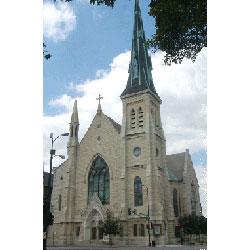
Following a blizzard and 20-inch snowfall, the roof of First Baptist Congregational Church, a historic church on Chicago's West Side, partially collapsed, sending bricks and roof materials into the sanctuary. No one was in the church at the time of the incident, which took place February 1.
Part of the church towers' facade on the southeast side of the church at 1613 W. Washington Blvd. toppled sometime overnight Tuesday in high winds and lightning. Stones weighing between 50 and 2,000 pounds caused two holes 10 to 15 feet wide. Some landed on the balcony and some in front of the church's main entrance. Church officials said one of the six chambers of the church's organ, a Kimball organ installed in 1927, was also damaged.
Construction on the church began in 1869 and was completed in 1871. The building survived the Great Chicago Fire of 1871. Originally built as the Union Park Congregational Church, it was designed by Gurdon P. Randall, who designed Northwestern University's University Hall in Evanston. It was named a state landmark in 2006 and a National Historic Landmark in 2007.
For more information: www.chicagojournal.com/Blogs/Near-Loop-Wire/02-04-2011/Blizzard_ravages_church_in_Near_West".
No estimate of the damage is yet available. The congregation was planning to move services to the Hope Institute Learning Academy across the street. A restoration fund for donations has been established at PNC Bank, 2154 W. Madison St., Chicago, IL 60612.


